Black And Decker G950C Handleiding
Black And Decker
Slijpmachine
G950C
Bekijk gratis de handleiding van Black And Decker G950C (6 pagina’s), behorend tot de categorie Slijpmachine. Deze gids werd als nuttig beoordeeld door 73 mensen en kreeg gemiddeld 4.9 sterren uit 37 reviews. Heb je een vraag over Black And Decker G950C of wil je andere gebruikers van dit product iets vragen? Stel een vraag
Pagina 1/6

•Check for misalignment or binding of moving parts, breakage of parts, and any other
condition that may affect the tools operation. If damaged, have the tool serviced
before using. Many accidents are caused by poorly maintained tools.
•Use only accessories that are recommended by the manufacturer for your model.
Accessories that may be suitable for one tool, may become hazardous when used on
another tool.
Service
• Tool service must be performed only by qualified repair personnel. Service or
maintenance performed by unqualified personnel could result in a risk of injury.
• When servicing a tool, use only identical replacement parts. Follow instructions in
the Maintenance section of this manual. Use of unauthorized parts or failure to follow
Maintenance Instructions may create a risk of electric shock or injury.
SAVE THESE INSTRUCTIONS
Specific Safety Rules
• Always use proper guard with grinding wheel. A guard protects operator from broken
wheel fragments. Always position the guard so that as much of the exposed disc as
possible is pointing away from you.
• Accessories must be rated for at least the speed recommended on the tool warning
label. Wheels and other accessories running over rated speed can fly apart and cause
injury.
• Hold tool by insulated gripping surfaces when performing an operation where the
cutting tool may contact hidden wiring or its own cord. Contact with a "live" wire will
make exposed metal parts of the tool "live" and shock the operator.
Additional Safety Rules
•ALWAYS WEAR EYE PROTECTION.
• WEAR EAR PROTECTION. NOISE LEVEL MAY BE AMPLIFIED WHEN GRINDING IN
ENCLOSED SPACES.
•KEEP GUARDS IN PLACE.
•Use only accessories having a maximum operating speed at least as high as the speed
specified in the warning on the tool’s label.
•Before using, inspect recommended accessory for cracks or flaws. If such a crack or flaw
is evident, discard the accessory. The accessory should also be inspected whenever you
think the tool may have been dropped.
•When starting the tool (with a new or replacement wheel or brush installed) hold the tool in
a well protected area and let it run for one minute. If the wheel or brush has an undetected
crack or flaw, it should burst or separate in less than one minute. Never start the tool with
a person in line with the accessory. This includes the operator.
•In operation, avoid bouncing the wheel or giving it rough treatment. If this occurs, stop the
tool and inspect the wheel.
• ALWAYS USE GUARDS with grinding wheels and wire brushes. Always position the
guard so that as much of the exposed wheel or wire brush as possible is pointing away
from you.
•Clean your tool out periodically.
•Do not use Type 1 flat cut-off abrasive or diamond wheels without proper guard. (Guard
not included with unit.)
WARNING: Some dust created by power sanding, sawing, grinding, drilling, and
other construction activities contains chemicals known to cause cancer, birth
defects or other reproductive harm. Some examples of these chemicals are:
• lead from lead-based paints,
• crystalline silica from bricks and cement and other masonry products, and
• arsenic and chromium from chemically-treated lumber (CCA).
Your risk from these exposures varies, depending on how often you do this type of work. To
reduce your exposure to these chemicals: work in a well ventilated area, and work with
approved safety equipment, such as those dust masks that are specially designed to filter
out microscopic particles.
•Avoid prolonged contact with dust from power sanding, sawing, grinding, drilling,
and other construction activities. Wear protective clothing and wash exposed areas with
soap and water. Allowing dust to get into your mouth, eyes, or lay on the skin may promote
absorption of harmful chemicals.
WARNING: Use of this tool can generate and/or disperse dust, which may cause
serious and permanent respiratory or other injury. Always use NIOSH/OSHA approved
respiratory protection appropriate for the dust exposure. Direct particles away from face and
body.
CAUTION: Wear appropriate hearing protection during use. Under some conditions
and duration of use, noise from this product may contribute to hearing loss.
WARNING: This product contains chemicals, including lead, known to the State of
California to cause cancer, and birth defects or other reproductive harm. Wash hands after
handling.
The label on your tool may include the following symbols.
V ..........................volts A..........................amperes
Hz ........................hertz W ........................watts
min ........................minutes ......................alternating current
......................direct current no ........................no load speed
..........................Class II Construction
........................
earthing terminal
........................safety alert symbol
SPM ................strokes per minute
.../min ....................revolutions or
reciprocations per minute
General Safety Rules
WARNING! Read and understand all instructions. Failure to follow all instructions
listed below may result in electric shock, fire and/or serious personal injury.
SAVE THESE INSTRUCTIONS
Work Area
•Keep your work area clean and well lit. Cluttered benches and dark areas invite
accidents.
•Do not operate power tools in explosive atmospheres, such as in the presence of
flammable liquids, gases, or dust. Power tools create sparks which may ignite the dust or
fumes.
•Keep bystanders, children, and visitors away while operating a power tool.
Distractions can cause you to lose control.
Electrical Safety
•Double insulated tools are equipped with a polarized plug (one blade is wider than
the other.) This plug will fit in a polarized outlet only one way. If the plug does not fit
fully in the outlet, reverse the plug. If it still does not fit, contact a qualified electrician
to install a polarized outlet. Do not change the plug in any way. Double insulation
eliminates the need for the three wire grounded power cord and grounded power supply
system.
•Avoid body contact with grounded surfaces such as pipes, radiators, ranges and
refrigerators. There is an increased risk of electric shock if your body is grounded.
•Don’t expose power tools to rain or wet conditions. Water entering a power tool will
increase the risk of electric shock.
•Do not abuse the cord. Never use the cord to carry the tools or pull the plug from an
outlet. Keep cord away from heat, oil, sharp edges or moving parts. Replace
damaged cords immediately. Damaged cords increase the risk of electric shock.
•When operating a power tool outside, use an outdoor extension cord marked "W-A"
or "W." These cords are rated for outdoor use and reduce the risk of electric shock.
Personal Safety
•Stay alert, watch what you are doing and use common sense when operating a power
tool. Do not use tool while tired or under the influence of drugs, alcohol, or
medication. Amoment of inattention while operating power tools may result in serious
personal injury,
•Dress properly. Do not wear loose clothing or jewelry. Contain long hair. Keep your
hair and clothing away from moving parts. Loose clothing, jewelry, or long hair can be
caught in moving parts.
•Avoid accidental starting. Be sure switch is off before plugging in. Carrying tools with
your finger on the switch or plugging in tools that have the switch on invites accidents.
•Remove adjusting keys or wrenches before turning the tool on. Awrench or key that is
left attached to a rotating part of the tool may result in personal injury.
•Do not overreach. Keep proper footing and balance at all times. Proper footing and
balance enables better control of the tool in unexpected situations.
•Use safety equipment. Always wear eye protection. Dust mask, non-skid safety shoes,
hard hat, or hearing protection must be used for appropriate conditions.
Tool Use and Care
•Use clamps or other practical way to secure and support the workpiece to a stable
platform. Holding the work by hand or against your body is unstable and may lead to a loss
of control.
•Do not force tool. Use the correct tool for your application. The correct tool will do the
job better and safer at the rate for which it is designed.
•Do not use tool if switch does not turn it on or off. Any tool that cannot be controlled with
the switch is dangerous and must be repaired.
•Disconnect the plug from the power source before making any adjustments,
changing accessories, or storing the tool. Such preventative safety measures reduce
the risk of starting the tool accidentally.
•Store idle tools out of reach of children and other untrained persons. Tools are
dangerous in the hands of untrained users.
•Maintain tools with care. Keep cutting tools sharp and clean. Properly maintained tools,
with sharp cutting edges are less likely to bind and are easier to control.
INFORMATION YOU SHOULD KNOW
• Wait until grinding wheel reaches full speed before applying work.
• Hold grinder at proper angle, as shown in Figure 11 and 12.
VEA EL ESPAÑOL EN LA CONTRAPORTADA.
SAVE THIS MANUAL FOR FUTURE REFERENCE.
INSTRUCTIVO DE OPERACIÓN, CENTROS DE SERVICIO Y
PÓLIZA DE GARANTÍA. ADVERTENCIA: LÉASE ESTE
INSTRUCTIVO ANTES DE USAR EL PRODUCTO.
CAT. NO. G950C FORM NO. 488316-00 Copyright © 2005 Black & Decker (APR-05) Printed in China
1. On/off switch
Interrupteur Marche/Arrêt
Conmutador de encendido y apagado
2. Lock-on button
Bouton de verrouillage en position de marche
Botón de bloqueo en encendido
3. Side handle
Poignée latérale
Mango lateral
4. Spindle lock
Bouton de verrouillage de la broche
Seguro del eje
5. Guard
Dispositif de protection
Protector
66
7
8
4
14
12
13
11
7
14
12
11
7
14
12
11
7
A
B
1415
5
12
34
5 6 7
4
4
4
4
4
4
4
4
4
4-
-
-
-
-
-
-
-
-
-1
1
1
1
1
1
1
1
1
1/
/
/
/
/
/
/
/
/
/
2
2
2
2
2
2
2
2
2
2”
”
”
”
”
”
”
”
”
”
A
A
A
A
A
A
A
A
A
AN
N
N
N
N
N
N
N
N
NG
G
G
G
G
G
G
G
G
GL
L
L
L
L
L
L
L
L
LE
E
E
E
E
E
E
E
E
EG
G
G
G
G
G
G
G
G
GR
R
R
R
R
R
R
R
R
RI
I
I
I
I
I
I
I
I
IN
N
N
N
N
N
N
N
N
ND
D
D
D
D
D
D
D
D
DE
E
E
E
E
E
E
E
E
ER
R
R
R
R
R
R
R
R
R
6
6
7
4
9
8
10
2
1
B E F O R E R E T U R N I N G T H I S P R O D U C T
F O R A N Y R E A S O N P L E A S E C A L L
1 - 8 0 0 - 5 4 4 - 6 9 8 6
IF YOU SHOULD HAVE A QUESTION OR
EXPERIENCE A PROBLEM WITH YOUR
BLACK & DECKER PRODUCT,
C
C
C
C
C A
A
A
A
A L
L
L
L
L L
L
L
L
L
1
1
1
1
1-
-
-
-
- 8
8
8
8
8 0
0
0
0
0 0
0
0
0
0 -
-
-
-
- 5
5
5
5
5 4
4
4
4
4 4
4
4
4
4 -
-
-
-
- 6
6
6
6
6 9
9
9
9
9 8
8
8
8
8 6
6
6
6
6
BEFORE YOU CALL, HAVE THE FOLLOWING INFORMATION AVAILABLE, CATALOG No.,
TYPE No., AND DATE CODE (e.g. 0130M). IN MOST CASES, ABLACK & DECKER
REPRESENTATIVE CAN RESOLVE YOUR PROBLEM OVER THE PHONE. IF YOU HAVE A
SUGGESTION OR COMMENT, GIVE US ACALL. YOUR FEEDBACK IS VITAL
TO BLACK & DECKER.
INSTRUCTION MANUAL
Catalog # G950C

•Do not operate this tool for long periods of time. Vibration caused by the operating
action of this tool may cause permanent injury to fingers, hands, and arms. Use gloves to
provide extra cushion, take frequent rest periods, and limit daily time of use.
Extension Cord
When using an extension cord, be sure to use one heavy enough to carry the current your
product will draw. An undersized cord will cause a drop in line voltage resulting in loss of
power and overheating. The table below shows the correct size to use depending on cord
length and nameplate ampere rating. If in doubt, use the next heavier gage. The smaller the
gage number, the heavier the cord.
Motor
Your tool is powered by a Black & Decker specified motor. Be sure your power supply agrees
with the nameplate marking. A marking of 120 volts, 50/60 Hz or 120 volts, AC only means
that the tool is designed to operate on normal 120 volt house current. Voltage decrease of
more that 10% will cause loss of power and overheating. All Black & Decker tools are factory
tested. If this tool does not run, check the power supply.
ASSEMBLY
WARNING: To prevent accidental operation, turn off and unplug tool before
performing the following operations. Failure to do this could result in serious
personal injury.
Attaching the Wheel Guard - Fig. 2
WARNING: NEVER GRIND OR BRUSH WITHOUT GUARD IN PLACE.
• Place the tool on a table, with the spindle (9) facing up.
• Place the spring washer (8) over the spindle and locate it on the shoulder (10).
• Place the guard (4) onto the tool as shown.
• Place the flange (7) over the spindle with the protruding pips towards the guard. Make sure
that the holes in the flange align with the screw holes.
• Secure the flange with the screws (6). Make sure that the screws are fully tight and that the
guard can be rotated.
Removing the Wheel Guard (For Sanding Only) - Fig. 3
CAUTION: To prevent loss of control, do not set tool down until accessory has completely
stopped turning.
This tool is fitted with a guard. For sanding only, you can remove the guard as follows:
• Remove the outer flange, disc and inner flange if they have been attached.
• Use a screwdriver to remove the screws (6).
• Remove the flange (7), guard (4) and spring washer (8). Store these parts carefully.
Adjusting the Guard
The guard can be rotated 90°.
• Rotate the guard as required.
Fitting the Side Handle
• A three position auxiliary handle (4) is furnished with your grinder and can be screwed into
either side of the grinder housing as well as into the top.
WARNING: This handle SHOULD BE USED AT ALL TIMES to maintain complete control
of the tool. Always make sure the handle is tight.
Fitting and Removing Depressed Center Wheels - Fig. 4 - 6
CAUTION: Never use any depressed-center wheels without the proper guard.
Fitting - Figure 4,5
• Fit the guard as described above.
• Place the inner flange (11) onto the spindle (7) as shown . Make sure that the flange(fig. 4)
is correctly located on the flat sides of the spindle.
• Place the disc (12) onto the spindle (7) as shown (fig. 4). If the disc has a raised center
(13), make sure that the raised center faces the inner flange.
• Make sure that the disc locates correctly on the inner flange.
• Place the outer flange (14) onto the spindle. When fitting a grinding disc, the raised center
on the outer flange must face towards the disc (A in fig. 5). When fitting a cutting disc, the
raised center on the outer flange must face away from the disc (B in fig. 5).
• Keep the spindle lock (5) depressed and tighten the outer flange using the two-pin spanner
(15) (fig. 6).
• When using a depressed-center wheel, hold the tool so that an angle of approximately 30°
exists between the wheel and the work.
• When using ready-mount or hubbed wheels, flanges are not required.
WARNING: Check rated speed on depressed-center wheel. Never use a wheel with
rated speed lower than the speed on the nameplate of the tool.
EDGE GRINDING
Edge grinding may be done with Type 27 depressed center wheels specifically designed for
this purpose. These wheels are available locally. They must not be subject to side pressure.
CAUTION: Wheels used for edge grinding may break if they bend or twist while being
used for cut-off work or deep grinding. To reduce the risk of serious injury, limit the use of
these wheels to shallow cutting and notching (less than 1/2” in depth). The open side of the
guard must be positioned away from the operator.
Removing - Figure 6
• Keep the spindle lock (5) depressed and loosen the outer flange (14) using the two-pin
spanner (15) (fig. 6).
• Remove the outer flange (14) and the disc (12).
Fitting Wire Cup Brushes & Stringer Bead/Cable Twist Brushes
Wire brushes screw directly on the spindle of the machine without the use of flanges. When
using wire brushes, thread firmly on spindle by hand.
Minimum Gage for Cord Sets
Volts Total Length of Cord in Feet
120V 0-25 26-50 51-100 101-150
240V 0-50 51-100 101-200 201-300
Ampere Rating
More Not more American Wire Gage
Than Than
0 - 6 18 16 16 14
6 - 10 18 16 14 12
10 - 12 16 16 14 12
12 - 16 14 12 Not Recommended
Fitting Abrasive Discs
Use an abrasive disc with a backing pad for sanding with your angle grinder.
• Remove the guard.
• Place the flange, (backing pad and abrasive disc sold separately) and outer flange on the
spindle as shown in shows how to attach an abrasive disc with aFigure 7. Figure 7A
rubber backing pad.
• Tighten the abrasive disc as shown in by depressing the spindle lock button andFigure 8
turning the abrasive disc by hand.
OPERATION
WARNING: Let the tool work at its own pace. Do not overload.
Switching On and Off
• To switch the tool on, press the on/off switch (1).
• For continuous operation, press the lock-on button (2) and release the on/off switch.
• To switch the tool off, release the on/off switch. To switch the tool off in continuous
operation, press the on/off switch once more and release it.
WARNING: Do not switch the tool off while under load.
Overload
Overloading will cause damage to the motor of your angle grinder. This can happen if
your angle grinder is subjected to heavy use for prolonged periods of time. Do not in any
circumstances, attempt to exert too much pressure on your angle grinder to speed up
your work. The abrasive discs operate more efficiently when light pressure is exerted,
thus avoiding a drop in the speed of your angle grinder.
SANDING
Precautions to Take When Sanding Paint
• Sanding of lead based paint is NOT RECOMMENDED due to the difficulty of controlling
the contaminated dust. The greatest danger of lead poisoning is to children and pregnant
women.
• Since it is difficult to identify whether or not a paint contains lead without a chemical
analysis, we recommend the following precautions when sanding any paint:
Personal Safety
• No children or pregnant women should enter the work area where the paint sanding is being
done until all cleanup is completed.
• A dustmask or respirator should be worn by all persons entering the work area. The filter should
be replaced daily or whenever the wearer has difficulty breathing.
NOTE: Only those dustmasks suitable for working with lead paint dust and fumes
should be used. Ordinary painting masks do not offer this protection. See your local
hardware dealer for the NIOSH approved proper mask.
Environmental Safety
• Paint should be removed in such a manner as to minimize the amount of dust generated.
• Areas where paint removal is occurring should be sealed with plastic sheeting of 4 mils
thickness.
• Sanding should be done in a manner to reduce tracking of paint dust outside the work
area.
GENERAL INFORMATION
Helpful Hints
• Hold your angle grinder with one hand on the body and the other hand firmly around the
side handle as shown in Figure 9.
• Always position the guard so that as much of the exposed disc as possible is pointing
away from you.
• Be prepared for a stream of sparks when the disc touches the metal.
• Maintain an angle between the disc and work surface ( ) of approximately 30° whenFig. 10
grinding and 10°-15° when sanding ( Fig. 11) for best tool control, material removal, and
minimal loading.
CAUTION: Use extra care when grinding into a corner as a sudden, sharp movement of
the grinder may be experienced when the wheel contacts a secondary surface.
WARNING: Always wear eye protection while operating this power tool.
Maintenance
Cleaning
Blowing dust and grit out of the motor housing using compressed air is a necessary
maintenance procedure.
CAUTION: Dust and grit from metal grinding often accumulate on interior surfaces and
could create an electrical shock hazard if not cleaned out.
Use only mild soap and a damp cloth to clean the tool. Never let any liquid get inside the
tool; never immerse any part of the tool into a liquid.
IMPORTANT: To assure product SAFETY and RELIABILITY, repairs, maintenance and
adjustment should be performed by authorized service centers or other qualified service
personnel, always using identical replacement parts.
Lubrication
Black & Decker tools are properly lubricated at the factory and are ready for use. Tools
should be lubricated regularly every year depending on usage. (Tools used on heavy duty
jobs and tools exposed to heat may require more frequent lubrication.) This lubrication
should be attempted only by trained power tool repairperson's such as those at Black &
Decker service centers or in other qualified service personnel.
Accessories
Recommended accessories for use with your tool are available from your local dealer or
authorized service center. If you need assistance regarding accessories, please call:
1-800-54-HOW-TO (544-6986).
WARNING: The use of any accessory not recommended for use with this tool could be
hazardous.
Service Information
Black & Decker offers a full network of company-owned and authorized service locations
throughout North America. All Black & Decker Service Centers are staffed with trained
personnel to provide customers with efficient and reliable power tool service.
Whether you need technical advice, repair, or genuine factory replacement parts, contact
the Black & Decker location nearest you. To find your local service location, refer to the
yellow page directory under "Tools—Electric" or call: 1-800-54-HOW TO.
Full Two-Year Home Use Warranty
Black & Decker (U.S.) Inc. warrants this product for two years against any defects in
material or workmanship. The defective product will be replaced or repaired at no charge in
either of two ways.
The first, which will result in exchanges only, is to return the product to the retailer from
whom it was purchased (provided that the store is a participating retailer). Returns should
be made within the time period of the retailer’s policy for exchanges (usually 30 to 90 days
after the sale). Proof of purchase may be required. Please check with the retailer for their
specific return policy regarding returns that are beyond the time set for exchanges.
The second option is to take or send the product (prepaid) to a Black & Decker owned or
authorized Service Center for repair or replacement at our option. Proof of purchase may
be required. Black & Decker owned and authorized Service Centers are listed under "Tools-
Electric" in the yellow pages of the phone directory.
This warranty does not apply to accessories. This warranty gives you specific legal rights
and you may have other rights which vary from province to province. Should you have any
questions, contact the manager of your nearest Black & Decker Service Center. This
product is not intended for commercial use.
FREE WARNING LABEL REPLACEMENT: If your warning labels become illegible or are
missing, call 1-800-544-6986 for a free replacement.
10 11
9
7A 8
See ‘Tools-Electric’
– Yellow Pages –
for Service & Sales
Imported by
Black & Decker (U.S.) Inc.,
701 E. Joppa Rd.
Towson, MD 21286 U.S.A.

Règles de sécurité - Généralités
AVERTISSEMENT! Lire et comprendre toutes les directives. Le non-respect de
toutes les directives suivantes présente des risques de secousses électriques, d'incendie ou
de blessures graves. CONSERVER CES DIRECTIVES
Zone de travail
• S'assurer que la zone de travail est propre et bien éclairée. Des établis encombrés et
des endroits sombres présentent des risques d'accidents.
• Ne pas utiliser des outils électriques en présence de vapeurs explosives (comme
celles dégagées par des liquides, des gaz ou des poussières inflammables). Les
étincelles générées par le moteur des outils électriques peuvent enflammer les poussières
ou les vapeurs.
• Éloigner les curieux, les enfants et les visiteurs de la zone de travail lorsqu'on utilise
un outil électrique. Une distraction peut entraîner la perte de maîtrise de l'outil.
Mesures de sécurité – Électricité
• Les outils à double isolation comportent une fiche polarisée (une lame plus large que
l'autre). La fiche n'entre que d'une façon dans une prise polarisée. Lorsque la fiche
n'entre pas à fond dans la prise, essayer de nouveau après avoir inversé les broches
de la fiche. Si la fiche n'entre toujours pas dans la prise, communiquer avec un
électricien certifié afin de faire installer une prise polarisée. Ne modifier en aucune
façon la fiche. La double isolation élimine le besoin d'un cordon trifilaire mis à la terre et
d'un système d'alimentation mis à la terre.
• Éviter de toucher à des surfaces mises à la terre comme des tuyaux, des radiateurs,
des cuisinières et des réfrigérateurs. Les risques de secousses électriques sont plus
élevés si le corps de l'utilisateur est mis à la terre.
• Protéger les outils électriques de la pluie ou des conditions mouillées. Une infiltration
d'eau dans l'outil augmente les risques de secousses électriques.
• Manipuler le cordon avec soin. Ne jamais se servir du cordon afin de transporter
l'outil ni tirer sur le cordon pour débrancher l'outil. Éloigner le cordon des sources
de chaleur, des flaques d'huile, des arêtes tranchantes et des pièces mobiles.
Remplacer immédiatement les cordons endommagés. Les cordons endommagés
augmentent les risques de secousses électriques.
• Lorsqu'on utilise un outil électrique à l'extérieur, se servir d'un cordon de rallonge
prévu pour l'extérieur, portant la mention “W-A” ou “W”. Ces cordons sont conçus
pour servir à l'extérieur et minimisent les risques de secousses électriques.
Sécurité personnelle
• Demeurer vigilant, prendre soin et faire preuve de jugement lorsqu'on utilise un outil
électrique. Ne pas s'en servir lorsqu'on est fatigué ou affaibli par des drogues, de
l'alcool ou des médicaments. De graves blessures peuvent résulter d'un moment
d'inattention lors de l'utilisation d'un outil électrique.
• Porter des vêtements appropriés. Éviter de porter des vêtements amples ou des
bijoux. Recouvrir la chevelure si elle est longue. Éloigner les cheveux, les vêtements et
les gants des pièces en mouvement qui peuvent les happer.
• Éviter les démarrages accidentels. S'assurer que l'interrupteur est en position hors
tension avant de brancher l'outil. Afin d'éviter les risques de blessures, ne pas
transporter l'outil avec le doigt sur l'interrupteur ni brancher un outil dont l'interrupteur est en
position sous tension.
• Enlever les clés de réglage avant de mettre l'outil sous tension. Une clé qui est laissée
sur une pièce rotative de l'outil présente des risques de blessures.
• Ne pas dépasser sa portée. Garder son équilibre en tout temps. On s'assure d'une
meilleure maîtrise de l'outil dans des situations imprévues grâce à une position stable et un
bon équilibre.
• Porter de l'équipement de sécurité. Toujours porter des lunettes de sécurité. Dans
certaines conditions, il faut porter des masques respiratoires, des chaussures
antidérapantes, un casque de sécurité ou des protège-tympans.
Utilisation et entretien de l’outil
• Utiliser des pinces de serrage ou de tout autre moyen pratique afin de fixer et de
soutenir la pièce à ouvrer sur une plate-forme stable. La pièce est instable lorsqu'elle
est retenue par la main ou le corps de l'utilisateur. Cela présente des risques de perte de
maîtrise de l'outil.
• Ne pas forcer l'outil. Utiliser l'outil approprié à la tâche. L'outil approprié fonctionne
mieux et sûrement lorsqu'on s'en sert à son rendement nominal.
• Ne pas se servir de l'outil lorsque l'interrupteur est défectueux. Le cas échéant, l'outil
est dangereux et il faut le réparer.
• Débrancher l'outil de la source d'alimentation avant de le régler, d'en remplacer les
accessoires ou de le ranger. On minimise de la sorte le risque de démarrage accidentel
de l'outil.
• Ranger l'outil hors de portée des enfants et de toute autre personne qui n'en connaît
pas le fonctionnement. L'outil est dangereux entre les mains de ces personnes.
• Prendre soin des outils. S'assurer que les outils de coupe sont tranchants et
propres. Des outils bien entretenus à arêtes tranchantes ont moins tendance à se coincer
et ils se maîtrisent mieux.
• Vérifier l'alignement et les attaches des pièces mobiles, le degré d'usure des pièces
ainsi que tout autre facteur susceptible de nuire au bon fonctionnement de l'outil.
Faire réparer un outil endommagé avant de s'en servir. Des outils mal entretenus sont
la cause de nombreux accidents.
• Utiliser seulement les accessoires recommandés par le fabricant. Des accessoires qui
conviennent à un outil peuvent présenter des risques avec un autre outil.
Entretien
• Confier l'entretien de l'outil seulement à du personnel qualifié. Le non-respect de la
présente directive présente des risques de blessures.
• Lors de l'entretien de l'outil, utiliser seulement des pièces de rechange identiques.
Respecter les consignes relatives à l'entretien du présent guide d'utilisation. Il y a
risque de secousses électriques ou de blessures lorsqu'on utilise des pièces non autorisées
ou lorsqu'on ne respecte pas les consignes relatives à l'entretien
CONSERVER CES DIRECTIVES
Règles de sécurité particulières
• Toujours utiliser le dispositif de protection qui convient à la meule afin de protéger
l’opérateur des fragments pouvant être projetés par une meule brisée.
• La vitesse des accessoires doit correspondre à la vitesse minimale recommandée
indiquée sur l’étiquette d’avertissement de l’outil, car les meules et les accessoires qui
sont réglées à une vitesse trop élevée peuvent se briser et occasionner des blessures
lorsque des fragments de métal sont projetés en l’air.
• Tenir l’outil par les surfaces isolées prévues à cette fin lorsqu’il risque d’entrer en
contact avec des fils cachés ou son propre cordon, car de tels contacts peuvent mettre
les pièces métalliques de l’outil sous tension, engendrant des risques de choc électrique.
Règles de sécurité Additionnelles
• TOUJOURS PORTER DES LUNETTES DE PROTECTION.
• PORTER UN DISPOSITIF DE PROTECTION POUR LES OREILLES. LE NIVEAU DE
BRUIT PEUT ÊTRE AMPLIFIÉ LORS DU MEULAGE EN ESPACE CLOS.
• TOUJOURS LAISSER LE DISPOSITIF DE PROTECTION EN PLACE.
• N'utiliser que des meules ayant une vitesse de fonctionnement maximale équivalant au
moins à la vitesse de rotation à vide (No Load RPM) marquée sur la plaque signalétique de
l'outil.
• Avant d’utiliser un accessoire recommandé, le vérifier afin de s’assurer qu’il n’y ait ni bris ni
fissure. Si on y trouve de tels défauts, mettre l’accessoire au rebut. Inspecter également
l’accessoire chaque fois qu’il subit une chute.
• Lorsqu’on démarre l’outil (après y avoir installé une meule neuve ou de rechange), se tenir
dans un endroit bien protégé et le faire fonctionner pendant une minute, car si l’outil est
fissuré ou brisé, il devrait éclater en moins d’une minute. Ne jamais démarrer un outil
lorsque quelqu’un, y compris l’opérateur, se tient directement devant lui.
• Éviter de faire rebondir la meule durant son fonctionnement ou de l’utiliser de manière
abusive. Si la meule subit de tels traitements, arrêter l’outil et inspecter cette dernière.
•TOUJOURS UTILISER UN DISPOSITIF DE PROTECTION lorsqu'on se sert de meules à
moyeu déporté ou de meules boisseaux coniques.
• Nettoyer l'outil périodiquement.
•Ne jamais utiliser de meules abrasives ou de meules diamant à tronçonner par trait bas de
Type 1 sans avoir d’abord installé un dispositif de protection adéquat. (Le dispositif de
protection n’est pas fourni avec l’outil.)
AVERTISSEMENT : Certains outils électriques, tels que les sableuses, les scies,
les meules, les perceuses ou certains autres outils de construction, peuvent
produire de la poussière contenant des produits chimiques susceptibles d’entraîner
le cancer, des malformations congénitales ou pouvant être nocifs pour le système
reproductif. Parmi ces produits chimiques, on retrouve :
• le plomb dans les peintures à base de plomb,
• la silice cristalline dans les briques et le ciment et autres produits de maçonnerie,
• l’arsenic et le chrome dans le bois de sciage ayant subi un traitement chimique
(comme l’arséniate de cuivre et de chrome).
Le risque associé à de telles expositions varie selon la fréquence avec laquelle on
effectue ces travaux. Pour réduire l’exposition à de tels produits, il faut travailler dans un
endroit bien aéré et utiliser le matériel de sécurité approprié, tel un masque
anti-poussières spécialement conçu pour filtrer les particules microscopiques.
• Éviter tout contact prolongé avec la poussière soulevée par cet outil ou autres
outils électriques. Porter des vêtements de protection et nettoyer les parties
exposées du corps à l’eau savonneuse. S’assurer de bien se protéger afin d’éviter
d’absorber par la bouche, les yeux ou la peau des produits chimiques nocifs.
AVERTISSEMENT : Cet outil peut produire et répandre de la poussière
susceptible de causer des dommages sérieux et permanents au système
respiratoire. Toujours utiliser un appareil respiratoire anti-poussières approprié approuvé
par le NIOSH ou l’OSHA. Diriger les particules dans le sens opposé du visage et du corps.
MISE EN GARDE : Porter un dispositif approprié de protection de l’ouïe lors de
l’utilisation du produit. Dans certaines conditions et durées d’utilisation, le produit peut
émettre un niveau de bruit provoquant la perte de l’ouïe.
•Ne pas utiliser cet outil pendant des périodes prolongées. Les vibrations causées par
l’action de fonctionnement de l’outil peuvent blesser en permanence les doigts, les mains
et les bras. Porter des gants pour amortir les vibrations, faire des pauses fréquentes et
limiter le temps d’utilisation quotidien de l’outil.
L’étiquette de l’outil peut comporter les symboles suivants.
V ....................................volts A..........................ampères
Hz ..................................hertz W ........................watts
min..................................minutes ......................courant alternatif
................................courant continu no ........................sous vide
....................................Construction de classe II
........................
borne de mise à la
minute
..................................symbole d´avertissement .../min ..................tours ou courses
à la minute
SPM.....................courses/min
AVERTISSEMENT : Le produit renferme des produits chimiques, dont du plomb.
Selon l’état de la Californie, ce produit chimique peut causer le cancer ainsi que des
malformations congénitales, et il présente d’autres dangers au système reproductif
humain. Se laver les mains après l’utilisation.
Rallonges
Lorsqu'on doit se servir d'une rallonge, il faut s'assurer qu'elle puisse transporter le courant
requis; si la rallonge est trop petite, la tension de ligne diminuera, provoquant une perte de
puissance et la surchauffe de l'outil. Le tableau ci-dessous indique le calibre à utiliser selon
la longueur du cordon et l'intensité nominale apparaissant sur la plaque signalétique. En cas
de doute, utiliser le calibre supérieur (il est à noter que plus le chiffre est petit, plus le calibre
du cordon est grand).
Moteur
Le moteur de cet outil a été conçu par Black & Decker. On doit s'assurer que l'alimentation
corresponde aux valeurs nominales de la plaque signalétique. La marque «120 volts, 50/60
Hz» ou «120 volts, AC only» (120 volts c.a. seulement) signifie que l'outil peut être alimenté
par un courant résidentiel standard. Les baisses de tension de plus de 10 % engendrent
des pertes de puissance et une surchauffe de l'outil. Tous les outils Black & Decker sont
testés en usine; si celui-ci ne fonctionne pas, on doit d'abord vérifier l'alimentation.
ASSEMBLAGE
AVERTISSEMENT : Pour prévenir tout accident, arrêter et débrancher l'outil avant
d’effectuer les opérations suivantes. Tout manquement à cette règle pose des risques de
blessure grave.
Fixation du dispositif de protection de la meuleuse (Fig. 2)
AVERTISSEMENT : NE JAMAIS MEULER OU BROSSER SANS LE DISPOSITIF DE
PROTECTION EN PLACE.
•Disposer l’outil sur une table, avec le coté broche (9) sur le dessus.
•Installer le disque à ressort (8) sur la broche puis le poser sur le support (10).
•Installer le dispositif de protection (4) sur l'outil comme illustré.
•Installer la bride (7) sur la broche avec les pointes en relief contre le dispositif de protection.
S’assurer que les trous sur la bride s’alignent avec les trous de vis.
•Fixer solidement la bride à l’aide des vis (6). S’assurer que les vis sont serrées à fond et
que le dispositif de protection peut tourner.
Retrait du dispositif de protection de la meuleuse (Ponçage
seulement) (Fig. 3)
MISE EN GARDE : Afin de ne pas perdre la maîtrise de l’outil, attendre que l’accessoire
se soit immobilisé complètement avant de déposer l’outil.
C’est outil est équipé d’un dispositif de protection. Pour le ponçage seulement, il est
possible de retirer ce dispositif de protection comme suit :
•Retirer la bride externe, le disque et la bride interne s’ils ont été fixés.
•Utiliser un tournevis pour retirer les vis (6).
•Retirer la bride (7), le dispositif de protection (4) et le disque à ressort (8). Mettre ces pièces
soigneusement de côté.
Réglage du dispositif de protection.
Le dispositif de protection peut faire une rotation de 90°.
•Faire tourner le dispositif de protection comme nécessaire.
Installation de la poignée latérale
•Une poignée auxiliaire à trois positions (4) est fournie avec l’outil; on peut l’installer d’un
côté ou de l’autre du logement, ainsi que sur le dessus de l’outil.
AVERTISSEMENT : IL FAUT UTILISER cette poignée EN TOUT TEMPS afin de bien
maîtriser l’outil. Toujours s’assurer qu’elle est fixée solidement.
Installation et retrait d’une meule à moyeu déporté (fig. 4 - 6)
MISE EN GARDE : Ne jamais utiliser de meules à moyeu déporté sans le dispositif de
protection adéquate.
Installation (Fig 4, 5)
• Installer le dispositif de protection comme décrit ci-dessus.
•Installer la bride interne (11) sur la broche (7) comme illustré en S’assurer que lafigure 4.
bride est correctement posée sur les côtés plats de la broche.
Calibre minimal des cordons de rallonge
Tension Longueur totale du cordon en pieds
120 V De 0 à 25 De 26 à 50 De 51 à 100 De 101 à 150
240 V De 0 à 50 De 51à 100 De 101 à 200 De 201 à 300
Intensité (A)
Au Au Calibre moyen de fil
moinsplus
0 - 6 18 16 16 14
6 - 10 18 16 14 12
10 - 12 16 16 14 12
12 - 16 14 12 Non recommandé
GUIDE D’UTILISATION
RENSEIGNEMENTS À RETENIR
• Attendre que la meule atteigne sa vitesse maximale avant de la poser sur l'ouvrage.
• Tenir la meuleuse à l'angle approprié, tel qu'illustré à la fig.11, fig. 12.
Product specificaties
| Merk: | Black And Decker |
| Categorie: | Slijpmachine |
| Model: | G950C |
Heb je hulp nodig?
Als je hulp nodig hebt met Black And Decker G950C stel dan hieronder een vraag en andere gebruikers zullen je antwoorden
Handleiding Slijpmachine Black And Decker

26 Augustus 2024

18 Juni 2024

8 Juni 2023

27 Mei 2023

24 Mei 2023

19 Mei 2023

12 Mei 2023

10 Mei 2023

9 April 2023

4 April 2023
Handleiding Slijpmachine
- Victoria Arduino
- Craftsman
- Gorenje
- Maktec
- Batavia
- Solo
- Hikoki
- Toolson
- ECG
- VOREL
- DeWalt
- Makita
- AEG
- Maestro
- Dolmar(Makita)
Nieuwste handleidingen voor Slijpmachine
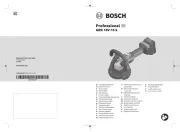
15 September 2025
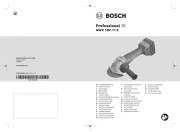
15 September 2025
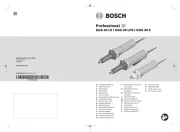
15 September 2025
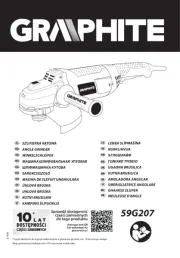
13 September 2025
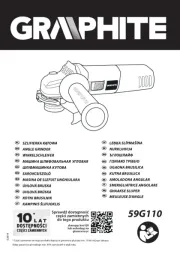
12 September 2025
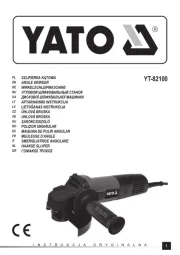
12 September 2025
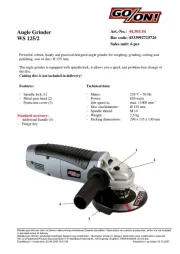
7 September 2025
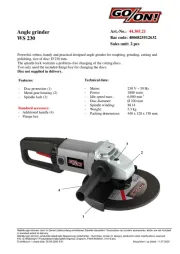
7 September 2025
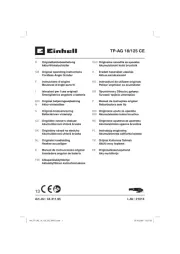
2 September 2025
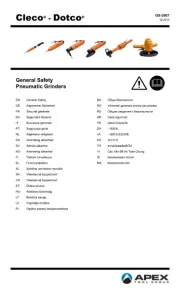
2 September 2025